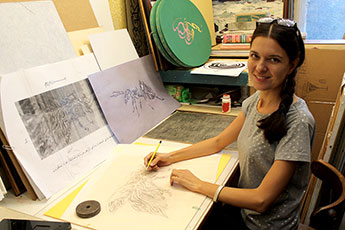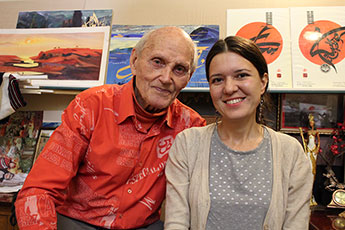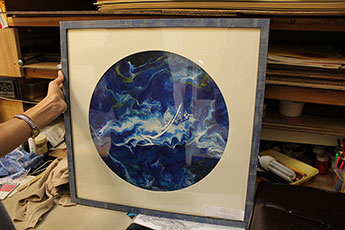Interview with Roza Khuzina
Roza Raysovna Khuzina, a calligraphy talent from Kazan, spoke to our magazine to share the details of her first, yet already successful, steps in the art of fine writing world, demonstrated some of her works and revealed future plans.
How did you come to calligraphy?
I used to draw a lot as a child, the typical children pictures or letters. Things got serious in my 9th grade; I entered Feshin Art School in Kazan and in 2009 – Naberezhnye Chelny Institute of Social and Pedagogical Technologies and Resources.
It took me long to find myself as an artist, before a miraculous occasion happened: in 2005 I saw the works by Vladimir Popov, and they gave me tingles immediately because the surahs and the Quran were so powerful. Ten years later I was privileged to meet Popov in person, before that I only knew his works, which inspired me.
I can relate to that, I found myself as an artist through Popov's works. Today he teaches me as I continue on my path. I am incredibly lucky! He usually takes no students. A friend of mine, she's a journalist, introduced me to him when she was writing a publication and asked me to help and take pictures of his works. When I entered the workshop, he took an interest in my activities and wanted to see my drawings. And we matched as he took an interest in me as an artist and as a person. From there I started to show him my sketches, and he gave me tips, teaching and directing me. I am progressing further and further these days.
Was there anybody else as your teacher?
No, there was Vladimir only. He's a very kind, patient and generous professional. The Almighty God helped me find him.
What is calligraphy for you?
It's an art of fine writing, a neat handwriting. It's like music that you compose in a single burst.
Do you believe one should follow their inspiration or schedule?
Inspiration only. Your muse will not be with you at all times.
Can you share the details of your creative process, what are the specifics of it?
Some people get on straight with their nibs, the other pencil it in and then outline; I have my own technique – I pencil the lines and then paint it. For me it's easier to start with a text and then transform it into a painting.
How do you come up with images and ideas for your works?
I read Quran, and it generates the images in my head because its message is so bright. It's a shame that I fail to understand the Arabic, though I can read a bit. I only learn it as a foreign language.
Why do you prefer word paintings to the traditional writing?
It's interesting to trial anything. I'm open to experiments, some techniques are yet not in my arsenal but I'm very keen to try. I take interest in anything associated with art, I enjoy discovering. I haven't yet mastered Gothic or Cyrillic but who knows, maybe the related ideas will come up too. It's always worth to try, you should develop and grow, attend workshops.
What traits should an individual possess if he or she decided to engage in calligraphy?
Talent, aspiration and true purpose matter.
What is your own purpose?
I want to hold a personal exhibition, and I am making small steps towards it as I create and accumulate works. I dream of my mother coming to the exhibition to see my achievements.
It'd be great to let people see the beauty. Our entire lives come in grey colour with so little bright spots around. I believe that one can inspire when looking at calligraphy because in our works we give praise to the Almighty God and reveal the beauty of the world to the people around us.
What impact does calligraphy have on you?
It calms me down. The Quran, a sacred book, is more than just words, it's the Almighty God's scripture. It resembles a meditation: when you paint, calligraphy absorbs you whole.
Do you believe that calligraphy contributes to the development?
Of course, it impacts your vision: you concentrate and shift gaze all the time, watch the diacritic marks etc. Calligraphy also helps develop fine motor skills.
Have you ever thought of teaching?
I don't think I have enough knowledge to be able to pass it on to the fullest extent. I'm still a student myself; my next goals are lettering and the other techniques, while I've only been doing it for three years. I take part in various exhibitions when they invite me – so far there have been twenty.
What is your favourite part of the process?
When a sketch comes out good, it makes me happy. It's like a baby: you conceive and bring it to the world. I create the way I feel colours, the images come from within.
How long does your work take?
It starts with a sketch. The shape follows the idea, and then you produce drafts etc. About a week, maybe.
Where should one start when engaging in the Arabic calligraphy? What is best to focus on?
Of course, the first step is to learn the alphabet. It comes as a foundation for learning, for example, Russian or English. Then proceed to writing letters in various styles to understand their composition. What is also very important is to find your teacher, today there is a lot of courses. And then you move forward and develop step by step.
Can you master calligraphy over the Internet?
You can if you have a goal. However, I believe, a face-to-face contact is much more important. Your teacher can always show you something, make a note or correction.
What can you wish to those who fall for calligraphy?
The key is to start and to follow your goal.
Calligraphy is a remedy and mental gymnastics.







